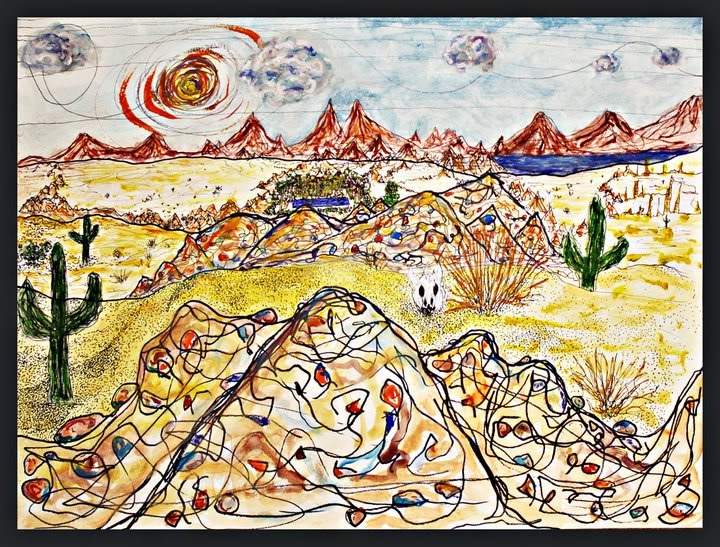 |
| *to be titled at a later date* C.T. Rasmuss, Marker layout for Lucid Mosaic (Dec. 2014). |
Lately I've been studying the Renaissance, the most I have since my courses in art school; this is all due to coming across and watching: 'A History of European Art', lecture on DVD(The Great Courses) by Professor William Kloss.
I've provided you with a link to it, as a resource which I keep renewing mine at the local library, from this course midway through the 48(30 min.) lectures, I've been inspired to finally attempt my rendition of Georges Rouault's, Madonna with Child(painted in 1920,but of a of a different name), which I saw and sketched quickly at the Dayton Art Institute, shown below:
 |
| Sketch of Rouault's Our Lady of the Fields C.T. Rasmuss |
Even before visiting "The Dayton" my 1st time, I'd already been influenced and mesmerized by Rouault's stained glass quality to his oil work(as he served as a stained glass apprentice in his youth), I'd also become to admire his authentic texture, and especially his subject matter(uncharacteristic of his Modernist peers art work, for the most part) along with his extreme empathy for these subjects, almost to realized ecstasy.
 |
| Notre Dame des Champs NO. 4 Georges Rouault, oil (1920). |
As you can see, I got the gist of Rouault's "Masterpiece", and last week when the spark hit me, I got the urge and grabbed the pre-fabricated canvas, and started drawing; from the very day I first saw, realized and sketched Rouault's "Madonna", I knew it was going to be one of my Lucid Mosaics, but I just didn't know when. To be even more specific, it was going to and still is going to be my first Lucid Mosaic involving a composition, that deals with a portrait setting:
 |
| *to be titled at a later date* C.T. Rasmuss, drawing (Dec. 2014). |
I'm not sure if this was on purpose or not, as it can take a lifetime to understand the lifetime of the great masters, so I wouldn't put it past Rouault, as it was obvious through his unique Renaissance subjects, that he must not have only studied the great painters of the period, but also their inventions and hidden ideas that they introduced and perfected. What I'm saying here is: in coming up with my own composition based from Rouault's, nearly 100 years earlier; I've noticed and capitalized upon an important central idea, found throughout much of Renaissance art, and that is the Trinity.
 |
| Trinity diagram C.T. Rasmuss, ink. |
In comparing my painting/drawing to the Rouault's original, the above Trinity triangle that I drew, overlaps our two paintings together by its central figures: Madonna and Christ child; with the top point rotating clockwise: 1. Mary's head, 2. Christ Child's head, and 3. is where they connect(Mary and Child).
All in all, it was an innate need for me(capturing the essence of bond between these two figures above all other aspects), I feel lucky that I was able to carry this most important aspect(representation of the Trinity composition wise) over into my own interpretation of an artist's great & successful rendering of this heavily sought narrative; also with a similar need to communicate this age old subject, I feel blessed to have the faith in being able to just go for it. Thereby receiving the reward of understanding, to which only this event could have given me!
To be continued..














